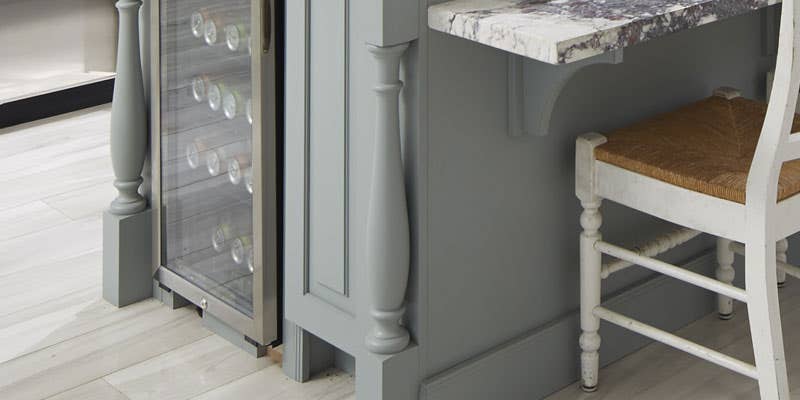Necessary Aspects to Think About When Selecting Legs For Kitchen Island
Selecting the proper legs for a kitchen island includes a careful evaluation of numerous factors that can substantially influence both performance and visual allure. As we explore these aspects, it comes to be clear that each decision can have significant effects for the overall kitchen area experience.
Product Options
When picking legs for a kitchen area island, recognizing the various material choices is essential for achieving both aesthetic allure and structural stability (Legs For Kitchen Island). The selection of product significantly influences not just the longevity of the island but also its general layout and functionality
Metal legs, typically made from stainless steel or wrought iron, contribute a industrial and modern-day feeling while making certain toughness and security. These materials are resistant to put on and can support considerable weight, making them ideal for bigger islands.
An additional option is engineered products, like MDF or plywood, which can be extra cost-efficient while still supplying a series of finishes. Nonetheless, they might not offer the exact same level of security as strong wood or steel. Products such as acrylic or glass can create a modern look, though they may call for extra support to make sure stability.
Inevitably, the choice of material for cooking area island legs ought to align with the wanted functionality and the total style of the cooking area.
Design And Style

When thinking about design, the form and surface of the legs are important. Conical legs can supply a sense of agility and beauty, while thicker, more robust legs can share stamina and stability. Additionally, the coating-- be it repainted, stained, or all-natural-- need to enhance the kitchen cabinetry and countertop products to develop a unified appearance.
Additionally, the style of the legs can likewise reflect individual preference. Custom or decorative legs, such as those including complex carvings or distinct geometric shapes, can act as prime focus, adding personality and personality to the cooking area. Eventually, the best choice will certainly not only enhance capability however also boost the visual appeal, making the cooking area island a standout function of the home.
Height Factors To Consider
Selecting the appropriate elevation for cooking area island legs is important, as it straight influences both performance and convenience. The basic elevation for a kitchen island usually varies from 36 to 42 inches, aligning with typical kitchen counter heights.

It is likewise important to account for customers' elevations and preferences. Tailoring the height can ensure a comfy experience for all family participants, making the kitchen area island a more functional and satisfying space.
Weight Assistance
Guaranteeing ample weight support for cooking area island legs is essential for both security and capability. The kitchen island usually serves numerous purposes, consisting of food preparation, dining, and added storage, demanding a robust assistance framework. When choosing legs, it is critical to think about the total weight capacity needed based upon the island's intended use and the products that will be positioned on other it.
The selection of material for the legs plays a considerable duty in their weight-bearing capabilities. Solid timber, steel, and heavy-duty composites usually offer remarkable toughness compared to lighter materials. Furthermore, the layout of the legs-- whether they are right, tapered, or have a pedestal form-- can influence their capability to disperse weight effectively across the structure.
Always consult the manufacturer's specifications regarding lots restrictions to make certain that the legs can maintain the desired weight without jeopardizing security. In summary, selecting cooking area island legs with ample weight assistance is necessary for producing a safe and functional cooking space.
Installation and Upkeep
Appropriate setup and upkeep of cooking area island legs are important for guaranteeing longevity and security. To begin, it is necessary to follow the maker's guidelines throughout setup. This commonly entails safeguarding the legs to the space station see here now utilizing appropriate bolts, guaranteeing that the legs are level and straightened. Utilizing a degree tool can help stop wobbling and boost the overall visual appeal of the kitchen area island.
Once set up, normal maintenance is needed to preserve the stability and look of the legs - Legs For Kitchen Island. For wood legs, regular cleansing with a damp cloth and application of ideal timber polish can stop dampness damage and preserve their coating. Steel legs may need a mild cleansing service to eliminate oil and grime, followed by a dry towel to prevent rust formation
Furthermore, check the legs regularly for signs of wear or damage, such as cracks or loose joints. Tightening screws or bolts as needed can additionally lengthen the lifespan of the legs. By adhering to these installation and upkeep techniques, homeowners can ensure that their kitchen island remains sturdy and aesthetically appealing for several years ahead.
Final Thought

Visual coherence is critical in choosing the check my reference style and style of legs for a cooking area island, as these components greatly influence the overall atmosphere of the room. Conical legs can give a feeling of agility and style, while thicker, more robust legs can convey strength and security.Picking the appropriate elevation for cooking area island legs is vital, as it straight influences both capability and convenience. In recap, choosing kitchen area island legs with appropriate weight support is vital for producing a safe and functional culinary area.
In conclusion, selecting legs for a kitchen island demands mindful factor to consider of different elements, including product choices, style, height, weight assistance, and installation.